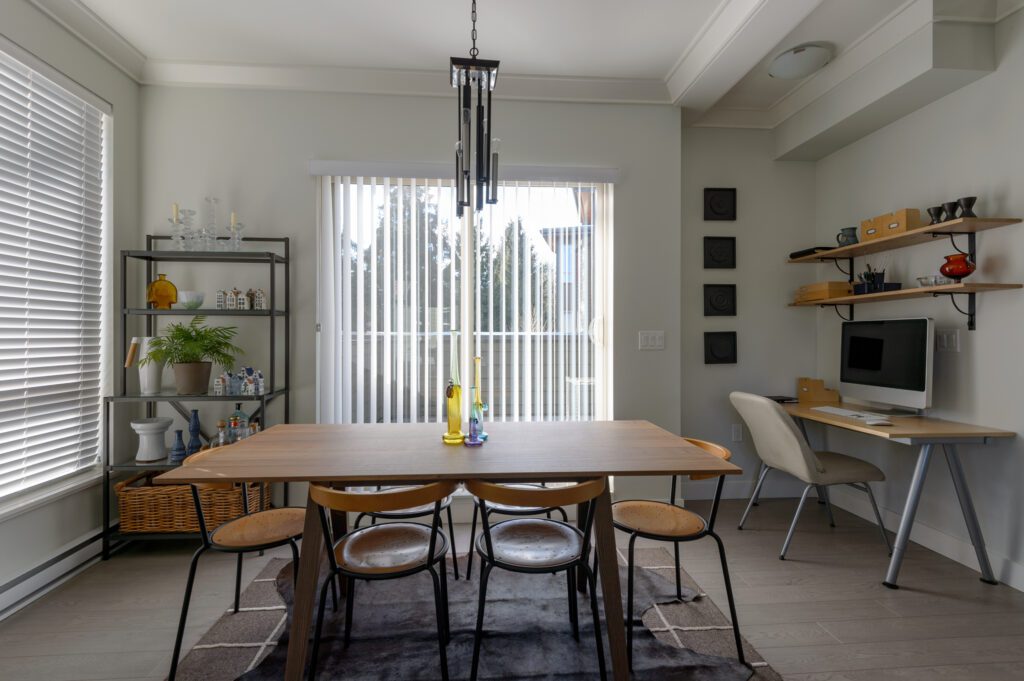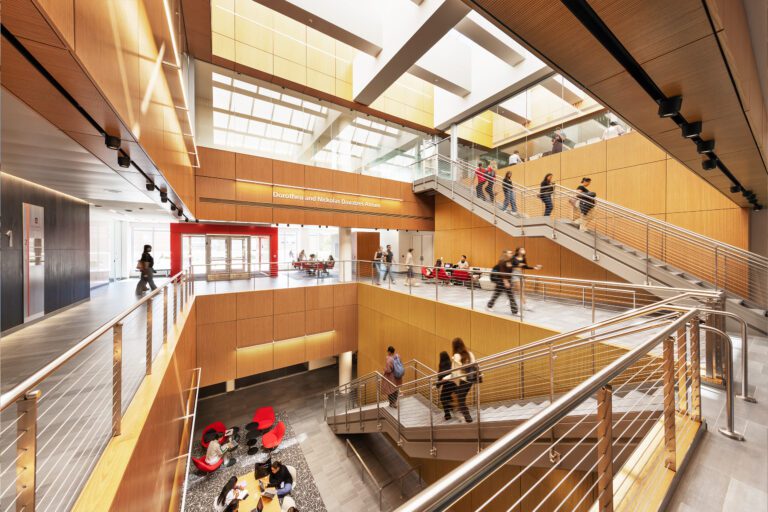Midcentury modern (MCM) design is a timeless style, grounded in minimalist principles but with plenty of room for artistry and unique touches.
If you’re designing an office space with a midcentury modern approach, wood panel walls are a must-have and an excellent starting point for your planning process. In the sections below, we’ll review the key elements of MCM aesthetics and outline the importance of including wood panels in your design.
A Brief History of Midcentury Modern Design
Midcentury modern design earned widespread recognition as a design movement thanks to Cara Greenberg’s 1984 book Midcentury Modern: Furniture of the 1950s.
Greenberg used the term to refer to a style that began in the 1930s and was dominant until around 1970. That style emphasizes these characteristics:
- Clean, neat lines
- Practicality
- Natural materials
- A general absence of embellishment
Throughout the middle decades of the 20th century, these principles were applied to architecture, interior design, product design, and even urban planning. The MCM movement represented a desire to move away from extravagant styles that came before, replacing excess with functionality and simplicity.
The Resurgence of Midcentury Modern Design in Contemporary Offices
The characteristics of midcentury modern design are not fad-like, and thus MCM never truly went out of style. However, there’s definitely a “you know it when you see it” quality to MCM which was less ever-present during the 70 and early 80s, while flashier aesthetics dominated fashion and design.
In the mid 80s, Cara Greenberg’s book helped define the style and bring about its resurgence, and since then its popularity has never really faded. By the 1990s, MCM was a dominant architectural and interior design style, and the premier of Mad Men in 2007 brought fresh enthusiasm for approaching entire buildings and spaces with an MCM sensibility.
While trends come and go, MCM is considered timeless. It’s a conservative and dignified style that holds perennial appeal alongside the fleeting fashions that come and go with each new decade.
The Importance of Wood Panels in Midcentury Modern Office Design
Midcentury modern design emphasizes the use of organic materials, and none more so than wood. Wood panels, especially in straightforward and minimalist arrangements, perfectly embody the core characteristics of MCM: clean lines, natural materials, connection to nature, and warm, calming tones and textures.
Wood also fits the color schemes that typify midcentury modern design. MCM colors are usually soft, such as olive green or denim blue. In particular, MCM is associated with mustard yellow and shades of orange and brown—hues that various wood species can either embody or complement perfectly.
Types of Wood Panels for Midcentury Modern Office Design
Any wood that’s popular as a building material can be used for wall or ceiling panels in a midcentury modern design. However, a few woods are particularly associated with the style. These include oak, teak, walnut, and rosewood.
Popular woods come in a broad variety of colors, from pale yellows to rich, dark browns. Thus, wood panel selection can occur in combination with other choices, such as flooring or furniture, to create a unified color scheme. Selecting an oil-based or water-based finish can further refine the color and vibrancy of the chosen wood.
Along with wood selection, your design process includes selecting a panel style. Wood panels come in numerous shapes and configurations, ranging from basic to extravagant. Typically, MCM design employs fairly simple panel designs, with straight vertical or horizontal lines and minimal flair. However, office space designs often include extra features for acoustic control, such as perforations that reduce reverberation.
Incorporating Wood Panels into Different Aspects of Office Design
Midcentury modern design is generally restrained and minimalist, but those qualities shouldn’t be confused for a lack of creativity. Rather, the defining characteristics of MCM design form a design framework. Each individual designer can find ways to explore the limits of that framework or to bend the rules as needed.
In MCM-style office spaces, wood panels can be used to great effect in spaces like private offices, conference rooms, lobbies, and hallways.
Balancing Wood Panels with Other Midcentury Modern Elements
As you incorporate wood panels into your MCM office space design, develop a plan for blending these variables into the overall theme:
- Color palettes – use wood hues that complement the other earth tone features in your space, while also pairing well with any bold accent colors that are present
- Lighting – use lighting options that fit the MCM style, such as pendant lights and floor lamps; incorporate as much natural lighting as possible
- Textiles, furniture, and accessories – MCM design employs clean lines and basic shapes to great effect; seek features that embody dignified yet eye-catching geometric shapes
When designing an entire space from scratch, it helps to start at the largest scale and work your way down. Begin with an overarching theme (MCM plus any additional defining design goals), then move on to selecting primary features such as wood walls, then add large elements such as furniture before completing the design with finishing touches.
The Benefits of Wood Panels for Office Well-Being and Productivity
Anchoring your MCM office design with wood panels isn’t just a great aesthetic and acoustic choice. It’s also an excellent way to create a warm and welcoming shared space for the people who will spend time there.
As a design movement that emphasizes natural materials and integration with nature, MCM provides opportunities for embracing biophilic design—developing human spaces that embrace connections with the natural world. Biophilic design is associated with stress reduction and pleasant work environments.
Upgrade Your Office Design With Wood Panels
What plans have you dreamed up for your office space? Whether your design vision is traditional, contemporary, or midcentury modern, wood panels can help bring your boldest ideas to life.
To discuss wood panel wall and ceiling systems for your next project, contact Rulon International today.




